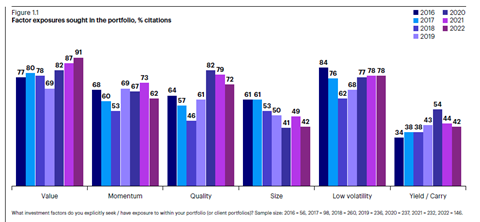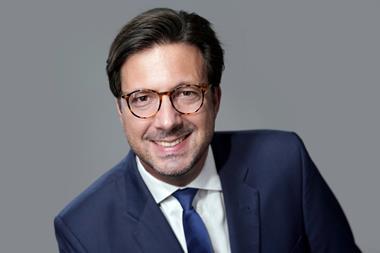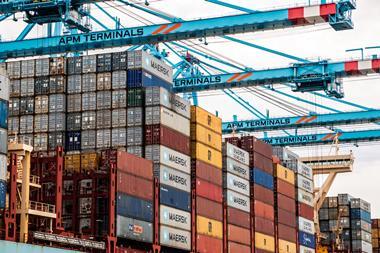Many pension funds have sold their factor exposures after years of disappointing performance. But interest in factor strategies is picking up once more as factor investors have benefited from changes in the macroeconomic backdrop.
The Dutch pension funds of AkzoNobel and Rabobank are just two examples of schemes that divested from equity factor strategies over the past few years. Factor managers, who tend to invest in boring, cheaply valued stocks, underperformed for years on end until 2020.
But times have changed: central banks across the globe have been hiking interest rates to fight inflation, and this has upended financial markets. The same tech and other growth stocks that were investor darlings over the past decade, but were shunned by factor investors because of their high valuations, have crashed.
“The market had ignored risk for a long time, but this has now changed,” said Guido Baltussen, head of factor investing at asset manager Robeco. “For example, old economy companies that until not so long ago were considered boring and therefore unattractive, have suddenly come back in favour,” he added.
Returns boost confidence in factor investing
Good returns have almost immediately translated into increased confidence, a recent study on factor investing by Invesco has shown.
A whole 64% of respondents said they now have more confidence in factor investing than a year ago. Value investing has especially returned to favour, with 91% of factors investors now having an exposure to this factor, up from 69% in 2019.
Investors expect factor investors to continue their recent streak of outperformance. Expectations are highest for the factors value and low volatility. The factor size, which centres on the belief that small companies outperform large ones over the long term, remains unpopular though.
Growth and manufacturing firms are overrepresented among small caps. Therefore, these companies are relatively vulnerable for rising interest rates and energy prices.
Underperformance

Pensioenfonds ING, the €27bn closed defined benefit (DB) pension fund of Dutch bank ING, has a factor investing mandate with Robeco containing exactly this type of companies.
The pension fund for years withstood “strong pressure” to sell its factor investments, according to Rens Bakker, investment manager at the pension fund.
“The returns on our factor investments, which were tilted towards defensive, dividend-paying value stocks, had been underperforming for years. So we asked ourselves whether perhaps the mandate should be managed passively instead,” he said.
In the end, the fund decided to stick with its factor mandate. “We often reviewed the business case and monitored it intensively. We concluded our factor investments had fallen victim to low interest rates, lockdown measures and the market preference for growth stocks, since valuation-wise our factor investments continued to become more attractive,” Bakker explained.
The pension fund did, however, let its factor mandate dilute somewhat over the years, Bakker added. “We did not add money during our rebalancing exercises because we first wanted to see the manager to again show outperformance versus the relevant factor index. Instead we added money to our passive index mandate.”
The fund could have benefited even more from the recent comeback. “Our factor mandate for developed markets has even generated a positive performance over the past year, with an outperformance versus the market index of 12%. For our emerging markets mandate the outperformance is even stronger at 20%,” Bakker said.
Over a five-year period the fund’s factor investments still show a “limited underperformance”, he added.
Moreover, the combination of low volatility and value factors in ING’s factor strategy now proves its worth as a hedge against inflation and rising rates, according to Bakker.
“We are now very happy with our factor investments. The value factor provides protection against rising interest rates while the low volatility factor is partly a hedge against inflation as it is tilted towards stable companies that can withstand a recession and can increase prices with inflation,” he said.
Increased interest
Investment consultants see interest in factor investing rise across Europe. “Customers want us to review their portfolios to see which factors they have exposure to,” said Weichen Ding of bfinance, a consultant that advises pension funds on their investment policy.
While Dutch pension funds are still sitting on the fence, Robeco’s Baltussen has noticed “enormous interest” in factor strategies from pension funds in the UK, Germany and the Nordics since Q4 of last year.
Many of those interested are new to factor investing. “It helps if you did not go through the painful experience of 2018-20. This probably plays a role too,” he said.

Fellow asset manager Invesco, which published its annual investor survey on factor investing last week, also sees an uptick in interest.
“We are seeing increased flows to factor strategies, with the money being diverted from growth equities and fundamental strategies,” said portfolio manager Georg Elsaesser, who noted that the value factor is especially popular.
“If clients prefer to invest in one specific sector, that is of course possible. But we recommend a diversified exposure to different factors,” he said.
ING wants combined factor/ESG mandate
As a closed pension fund, Pensioenfonds ING invests relatively little in equities, with its 17% equity exposure divided across two active factor mandates and two passive index mandates (for developed and emerging markets).
Within several years, the fund wants to simplify its equity portfolio, according to Bakker.
In the new set-up, it wants to integrate ESG-criteria in its factor investing approach. Adding factors to the mix can enhance a factor portfolio, noted Robeco’s Baltussen.
“If you select companies purely on their CO2 intensity without correcting for valuations, then you will end up with a portfolio full of very expensive companies,” he said.
Two thirds of respondents to an annual study on factor investing by Invesco now believe that factor investing and ESG are a good combination. A year ago, only 42% believed so.
The latest digital edition of IPE’s magazine is now available





































No comments yet